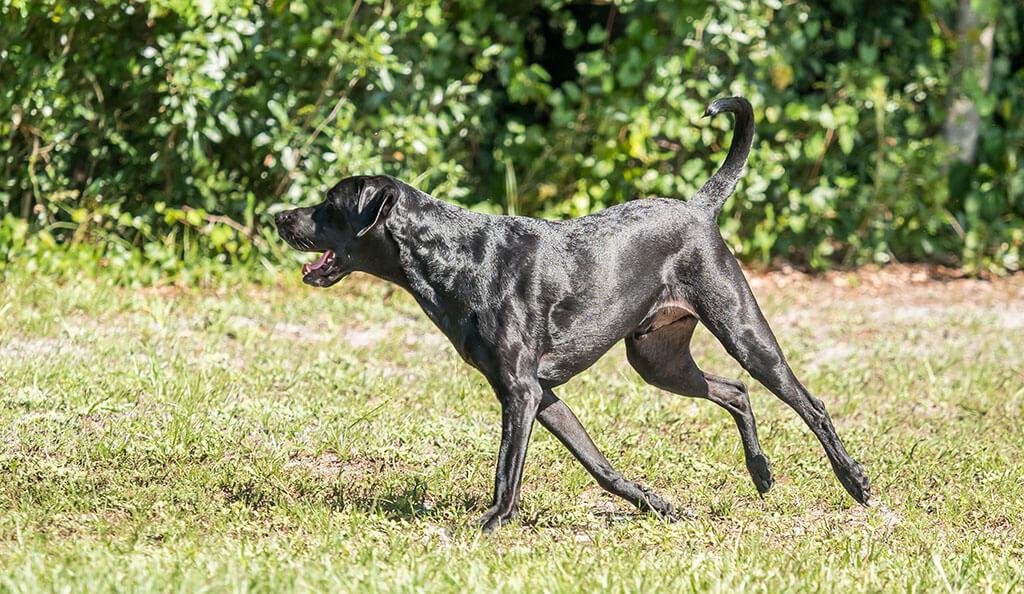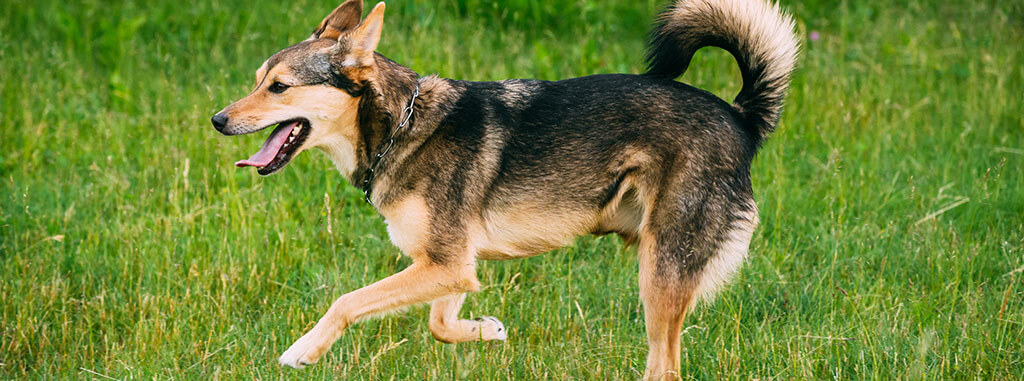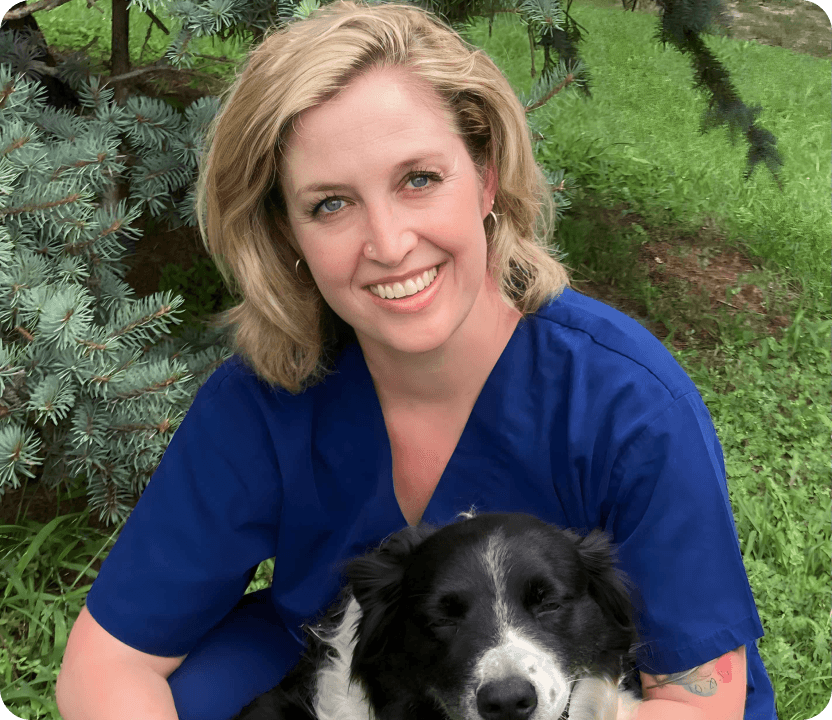Let’s delve into the complex condition: hip dysplasia. A developmental disease affecting dogs’ hip joints, leading to joint health issues. Discover symptoms, causes, and treatment options, here…
Hip Dysplasia in Dogs: From Symptoms to Treatment

Hip dysplasia is a developmental disease of the “ball and socket” joint of the hip during puppyhood, where the components of the hip joint do not grow at equal rates as they should. This leads to increased laxity, or looseness, of the hip joint. As the puppy matures and the body attempts to stabilize the “loose” joint, degenerative joint disease (arthritis) typically develops. Clinical signs such as lameness can be seen early on during puppyhood or as adults when arthritis begins to develop within the hip joint. Although hip dysplasia is more common in large-breed dogs, it can also occur in small dogs and even cats.
In this article, we will take a more in-depth look at hip dysplasia and its possible causes, as well as the most common risk factors that are currently associated with the development of hip dysplasia in dogs. In addition, we will discuss symptoms that may indicate your dog has hip dysplasia, the available treatment options, and measures that can and should be taken to prevent the development of hip dysplasia in dogs. Ultimately, potential pet parents should do their research before acquiring a new puppy, especially if they are considering a large breed.
Key facts
- Hip dysplasia is a developmental disease of puppies, especially large breeds, in which the components of the hip joint (the “ball and socket”) do NOT grow at the same rate, resulting in increased laxity (looseness) of the hip joint(s) and secondary degenerative joint disease (arthritis).
- While primarily caused by poor genetics, certain risk factors such as nutrition, obesity, environment, exercise, neutering age, and certain breeds may increase the incidence of hip dysplasia in dogs.
- Common symptoms of hip dysplasia in dogs include an abnormal gait in the hindlimbs, lameness without injury, difficulty jumping on and off things or going upstairs, muscle loss in the thighs, and abnormally “calm” behavior in puppies.
- The severity of hip dysplasia and the pet’s age typically determine the treatment options.
- Treatment for hip dysplasia in dogs includes surgical and non-surgical options.
- Management of dogs living with hip dysplasia includes: providing daily, low-intensity exercise; preventing obesity; avoiding stairs and utilizing ramps; providing a soft place to sleep/rest; making sure frequented areas are free of clutter and surfaces are anti-slip.
- Prevention of hip dysplasia includes responsible breeding practices such as screening breeding dogs via the OFA technique or PennHIP procedure BEFORE breeding.
What is Hip Dysplasia?
As stated in the introduction above, hip dysplasia is a common developmental orthopedic (bone) condition of large-breed puppies during growth. During this phase, the components of the hip joint fail to grow and develop normally. To more fully understand this condition in dogs, let’s take a moment to review the anatomy of the dog’s hip joint.
The hip (coxofemoral) joint in normal dogs is composed of the femoral head (the round “ball” portion of the hip joint) that connects the femur (hip bone) to the dog’s pelvis. The acetabulum is the “socket” portion of the pelvis where the femoral head (“ball”) normally fits snugly and glides smoothly in the joint as the dog moves its hindlimbs. However, when a dog has hip dysplasia, the “ball” (femoral head) and “socket” (acetabulum) do not fit smoothly together. The “socket” is often flattened and shallow, and the “ball” is often thickened and irregular. This results in increased laxity, or “looseness,” within the hip joint. Ultimately, the instability within the affected hip joint leads to abnormal wear of the bone and cartilage of the joint, joint dysfunction, development of arthritis, increasing pain, and decreased mobility.
While hip dysplasia in dogs is primarily caused by poor genetics, several other risk factors may increase the risk of developing hip dysplasia. Risk factors include:
- Nutrition: Studies have shown that free-feeding large-breed puppies can lead to rapid and abnormal growth of the muscles, bones, and joints.
- Obesity: Maintaining a lean body condition can help lessen the signs of arthritis.
- Environment and Exercise: Some studies have shown an increased risk of hip dysplasia in puppies that were allowed to run up the stairs before 3 months of age, although this has not been as extensively studied as the effects of nutrition on the development of hip dysplasia. In contrast, a decreased incidence of hip dysplasia has been found in those puppies that were allowed to run off-leash before 3 months of age, as well as those born on a farm and those born in the spring and summer.
- Neutering Age: While somewhat controversial, studies have indicated that early neutering (before 5.5 months of age) may be linked to an increased incidence of hip dysplasia in dogs.
- Breed predisposition: German Shepherds, Saint Bernards, Labrador Retrievers, Great Danes, and Golden Retrievers are some of the most commonly affected dog breeds, although any large or giant breed dogs are at risk of developing hip dysplasia.

Symptoms and Diagnosis
While signs of hip dysplasia can be seen in puppies as young as 3-4 months old, the majority of dogs do not exhibit symptoms until they are typically 1-2 years of age. The symptoms can vary depending on the severity of the condition. Common symptoms of hip dysplasia may include:
- Stiffness or limping
- Swaying, “bunny hopping” gait in the hindlimbs
- Lameness without previous trauma or injury
- Difficulty rising, jumping on and off furniture, going upstairs, or jumping into cars
- Abnormal sitting positions
- Difficulty standing for extended periods
- Loss of thigh muscle mass
- Pain
- Decreased range of motion in hindlimbs
- Abnormal sounds from joints
- Abnormally quiet or calm behavior in a puppy
Diagnosis of hip dysplasia is typically made through a combination of physical examination and diagnostic imaging (x-rays).
Upon examination, an abnormal gait in the hindlimbs is usually noted, specifically a “swaying” gait when walking and a “bunny hopping” gait when going upstairs. Weight-bearing lameness may or may not be present during the examination, and palpation of the hip joints may elicit pain and reveal a decreased range of motion.
An additional palpation technique commonly used to diagnose hip dysplasia in young dogs is the Ortolani Palpation Method. This technique is used to demonstrate the presence of hip laxity (looseness) by attempting to manually displace the femur (hip) bone, which will then produce an audible “clunking” sound when the femur returns to the socket. This technique normally requires sedation or general anesthesia and is especially helpful for diagnosing hip dysplasia in dogs and cats.
Diagnostic radiographs, or x-rays, remain the primary method used to diagnose hip dysplasia and also document its severity in dogs and cats. Because these X-rays require significant extension of the hips and precise positioning to obtain accurate results, sedation or general anesthesia is utilized. The resulting X-rays are used to determine both the presence and severity of hip dysplasia and evaluate the hip joints for signs of degenerative joint disease (arthritis).
The Stages and Severity of Hip Dysplasia
Clinical signs in dogs vary greatly depending upon factors such as the severity of the condition and the individual dog themselves. Some dogs will have extreme findings on X-rays but will exhibit minimal symptoms, while other dogs will have very mild findings on X-rays and seem to experience significant discomfort. Other factors that influence the severity of the condition and clinical signs of hip dysplasia may include the dog’s weight (heavier animals do not tolerate increased stress on their joints as well as leaner animals) and the muscle mass that is responsible for supporting the affected hip joints (younger animals tend to have more muscle mass and therefore more support of painful joints).
As the condition progresses, the “ball and socket” joint becomes more irregular, resulting in the development of degenerative joint disease, or arthritis. This means that not only is there significantly increased laxity (looseness) within the abnormal hip joints, but there is also new, abnormal bone formation within the joint space that causes increased pain and inflammation as well as decreased mobility. Ultimately, your dog can no longer participate in or perform the activities that he or she once enjoyed, or at least not without increased discomfort and difficulty on their part. Even necessary tasks such as going outside and posturing to urinate or defecate may become increasingly difficult and painful.
Treatment Options
Treatment of hip dysplasia depends upon the individual dog’s symptoms and degree of discomfort. Treatment options include both non-surgical (conservative medical management) and surgical methods. Supportive, non-surgical medical management is typically attempted before surgical procedures. However, some surgical options are limited to certain time frames during the puppy growth phase.
Supportive medical management is common and includes the management of joint pain and inflammation using non-steroidal anti-inflammatory drugs, or NSAIDs. There are several effective options for NSAIDs, and they are typically chosen on an individual basis. Additional pain medications that are commonly used in conjunction with NSAIDs include gabapentin, tramadol, and amantadine. Basic bloodwork is recommended every 6-12 months to ensure that internal organ damage is not occurring.
Medical management may also include joint supplements or diets specifically for joint health that contain ingredients such as glucosamine and chondroitin sulfate to promote joint health and reduce the progression of arthritis development. It is important to note that these must be given consistently, daily, to be effective. Injectable therapies are also available that may improve or preserve joint health.
If necessary, weight loss in overweight dogs with hip dysplasia is going to be of utmost importance in reducing the pain and discomfort associated with the condition and resulting arthritis. This will reduce the stress placed on the affected joints and ultimately result in less pain and discomfort for your dog. Daily exercise (most commonly in the form of leash walking) is, therefore, still recommended for dogs with hip dysplasia.
Physical therapy (i.e. underwater treadmill and strengthening exercises) may also help to reduce pain and inflammation and can be coupled with integrative treatment methods such as acupuncture, cold laser therapy, and massage.
For dogs that do not respond adequately to medical management, the most common surgical options for adult dogs include total hip replacement (THR) and femoral head/neck ostectomy (FHNO). In contrast, the most common procedures performed in puppies are the Juvenile Pubic Symphysiodesis (JPS) and the Triple Pelvic Osteotomy (TPO).
Total hip replacement, or THR, is a good option for adult, large, or giant-breed dogs with severe hip dysplasia and are no longer responding to conservative medical management. In this procedure, the surgeon replaces the entire “ball and socket” portions of the hip joint with metal or plastic implants. Although this procedure eliminates the majority of the pain associated with hip dysplasia due to the return to almost normal joint function, this procedure is also the most expensive option.
When a THR is not financially feasible for the pet owner, a femoral head/neck ostectomy (FHNO) is also a great option, especially for a small or medium-breed dog. This procedure also has the advantage of being able to be performed in young and adult dogs. This surgery essentially removes the “ball” (head) of the hip bone and results in the body forming a “false” joint composed of scar tissue. While this procedure does NOT recreate the normal joint function of the hip, it is very effective in reducing the pain caused by hip dysplasia.
The two most common surgical procedures available for puppies are the Juvenile Pelvic Symphisiodesis (JPS) and the Triple Pelvic Osteotomy. Both of these procedures are used to preserve the anatomy of the hip joint to prevent or reduce the degree of arthritis that will develop later by changing the angle of the pelvic bones by causing premature closure of the pelvic growth plates or by making multiple incisions in the bone of the pelvis and adjusting the angles of these bones to obtain better coverage of the femoral heads by the acetabulum. While these procedures are typically less expensive than a THR, they can only be performed in certain cases of puppies who are a certain age.

Living with Hip Dysplasia
As mentioned in the above treatment section, weight loss or maintenance of a lean body condition is extremely important in the management of pain in dogs with hip dysplasia. Decreasing your dog’s weight and maintaining a lean body condition is going to significantly reduce the stress on your dog’s joints, which decreases discomfort as a result.
Additional recommendations for improving your dog’s comfort and mobility include:
- Exercise daily, but decrease the intensity. Leash walks or swimming are great options.
- Avoid jumping and other high-impact exercises, especially on hard surfaces.
- Avoid stairs when possible and utilize ramps when necessary.
- Provide a soft sleeping/resting area, ideally an orthopedic pet bed.
- Place rugs on slippery surfaces to help avoid slips and falls.
- Consider using dog-specific “toe grips” to keep your dog from slipping.
- Keep your dog warm during winter months to reduce pain associated with arthritis.
Prevention and Breeding Considerations
Because hip dysplasia in dogs is a hereditary condition and some large and giant-breed dogs are born with the condition, there is no way to prevent hip dysplasia. However, there are some things that pet owners can do to reduce the risk of their dogs developing this condition. These preventive strategies should include: feeding an appropriate diet to your puppy to prevent excessive bone and joint growth, providing appropriate levels of exercise for your puppy to prevent obesity, and also starting high-risk dogs on joint supplements as early as 3 months of age to ensure good joint health and protect the joint cartilage. Finally, prospective dog owners should be sure to do their research on their breed of choice before acquiring their new puppy and take care to find a responsible breeder.
Responsible breeders, on the other hand, can prevent inherited hip dysplasia by screening their breeding dogs via two methods, the Orthopedic Foundation for Animals (OFA) technique or the PennHIP (Pennsylvania Hip Improvement Program) procedure.
The OFA technique is the most commonly used method for screening breeding animals. Using this technique, a dog intended for breeding can have an x-ray of the hips done at 24 months of age or older. This technique requires sedation or general anesthesia. Radiologists then evaluate the x-ray, and the dog receives a “score.” Breeding dogs with a score of “good” or “excellent” receive a registration number and are considered OFA-certified to produce offspring with a lesser chance of developing hip dysplasia. However, prospective owners should be aware that OFA certification is not a 100% guarantee that neither the breeding parents nor their offspring will go on to develop symptoms of hip dysplasia in the future. Unfortunately, at this time, parental certification is the best option available.
In contrast, the PennHIP procedure is performed on puppies as young as 16 weeks (4 months) of age and is based on the review of two different X-rays. This technique also requires anesthesia to obtain the best views. A measurement called a distraction index is then calculated from the two views, with the idea being that a tighter-fitting hip is going to be less likely to develop hip dysplasia in the future. Similarly, the PennHIP procedure is used to select the best animals for breeding purposes.
Final Thoughts on Canine Hip Dysplasia
As we have discussed in this article, hip dysplasia in dogs is a common developmental disease of large and giant-breed puppies where abnormal growth of the “ball and socket” joint results in increased laxity, or “looseness,” of the hip joint(s). Degenerative joint disease, or arthritis, of the hips is a common sequelae of canine hip dysplasia.
While hip dysplasia in dogs is considered an inherited condition, additional risk factors such as nutrition and obesity can also play a crucial role in the development of this disease. Symptoms such as an abnormal gait in the hindlimbs, difficulty going upstairs, or abnormally “calm” behavior in a puppy should be brought to the attention of your veterinarian immediately. If hip dysplasia is confirmed in your dog, your veterinarian can work with you and your pet to provide the most appropriate and effective medical or surgical treatment, as well as environmental or lifestyle modifications. In addition, prospective pet parents should do their research thoroughly on their chosen breed before purchasing a puppy and should only use responsible breeders when doing so.
Finally, the prognosis for dogs with hip dysplasia is generally good, and the majority of dogs can lead a normal, healthy life. However, it is important to note that those dogs that are diagnosed early in the course of the disease (i.e. as soon as symptoms are noted), generally tend to do better as medical or surgical treatments can be implemented sooner and may be more effective.
FAQs
What is Hip Dysplasia in Dogs?
Hip dysplasia is a common developmental disease in dogs, especially large breeds, where the hip joint’s “ball and socket” don’t grow at the same rate, leading to looseness.
What Causes Hip Dysplasia?
While primarily due to genetics, factors like nutrition, obesity, exercise, environment, neutering age, and breed can increase the risk.
What are the Symptoms of Hip Dysplasia?
Symptoms include abnormal gait, lameness, difficulty in jumping or climbing stairs, loss of thigh muscle mass, and unusual calmness in puppies.
How is Hip Dysplasia Diagnosed?
Diagnosis is made through a combination of physical exams, the Ortolani Palpation Method, and diagnostic imaging like X-rays under sedation or anesthesia.
What are the Treatment Options?
Treatment can be surgical or non-surgical, including NSAIDs, pain medications, joint supplements, weight management, and physical therapy. Surgical options vary based on the dog’s age and condition severity.
Can You Prevent Hip Dysplasia?
Prevention involves responsible breeding with screening methods like OFA and PennHIP, proper nutrition, appropriate exercise, and possibly starting high-risk dogs on joint supplements early.
Can Dogs with Hip Dysplasia Live a Normal Life?
Yes, with early diagnosis and appropriate treatment, most dogs with hip dysplasia can lead a normal and healthy life, although adjustments may be needed to manage pain and mobility.
Sources
https://www.petmd.com/dog/conditions/musculoskeletal/c_dg_hip_dysplasia
https://vcahospitals.com/know-your-pet/hip-dysplasia-in-dogs
https://www.vin.com/members/cms/project/defaultadv1.aspx?pid=607&id=4953618&f5=1
https://veterinarypartner.vin.com/default.aspx?pid=19239&id=4952203
https://www.facebook.com/groups/dogswithhipdysplasia/
https://www.facebook.com/groups/caninehipdysplasiasupport/
 J
J



